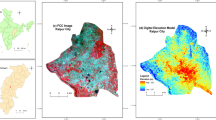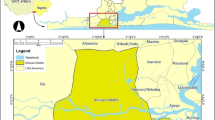Abstract
In this paper, the data of Advanced Very High Resolution Radiometer (AVHRR) 1 km resolution of daily time series is used to extract the distribution of seasonal snow in the Chowkibal-Tangdhar (CT) area. Shuttle Radar Topography Mission Digital Elevation Model (SRTM DEM) at 90-m resolution has been used to delineate the terrain characteristics such as aspect, slope, and altitude. The study is focused on two major objectives, first is to assess the snow cover variation with a time series analysis and second one is the snow cover changes with respect to the changes in terrain parameters mainly at avalanche prone regions. Study area has 60 registered avalanche sites; most of these avalanches trigger during the winter months when snow deposition takes place in the steep slopes due to successive snowfall spells. Normalized Difference Snow Index (NDSI) method is used to monitor the snow cover of the study area from the satellite image. The multi-temporal analysis of the snow cover derived from the AVHRR data shows that the binary snow cover in the study area increases with time from November to March due to successive snowfalls. After that, the snow cover starts to deplete from the mid-March onwards due to rise in temperature. Maximum snow cover area (SCA) has been found 85.67% and minimum is at 14.33% respectively. An attempt has been made to understand the influence of terrain parameters by extracting the major terrain and snow parameters for each of the avalanche site and correlating it with occurrences of the avalanches. The study suggests that the sites having terrain characteristics of slope 25–45°, aspect 26.45%, and altitude 2500–3500 m has more occurrences of avalanches.













Similar content being viewed by others
References
Bavay M, Lehning M, Jonas T, Löwe H (2009) Simulations of future snow cover and discharge in alpine headwater catchments. Hydrol Process 23(1):95–108
Blunden J, Arndt DS, Achberger C, Ackerman SA, Albanil A, Alexander P (2017) State of the climate in 2016. Bull Am Meteorol Soc 98(8):1–238
Crawford CJ, Manson SM, Bauer ME, Hall DK (2013) Multitemporal snow cover mapping in mountainous terrain for Landsat climate data record development. Remote Sens Environ 135:224–233. https://doi.org/10.1016/j.rse.2013.04.004
Dietz AJ, Kuenzer C, Conrad C (2013) Snow-cover variability in central Asia between 2000 and 2011 derived from improved MODIS daily snow-cover products. Int J Remote Sens 34(11):3879–3902
Dozier J (1989) Spectral signature of alpine snow cover from the Landsat Thematic Mapper. Remote Sens Environ 28:9–22
Foppa N, Wunderle S, Hauser A (2004) Operational sub-pixel snow mapping over the Alps with NOAA AVHRR data. Ann Glaciol 38(1):245–252
Gul C, Kang S-c, Ghauri B, Haq M, Muhammad S, Ali S (2017) Using Landsat images to monitor changes in the snow covered area of selected glaciers in northern Pakistan. J Mt Sci 14(10):2013–2027
Jain SK, Goswami A, Saraf AK (2009) Role of elevation and aspect in snow distribution in Western Himalaya. Water Resour Manag 23(1):71–83
Joshi JC, Ganju A, Sharma V (2010) A new approach to avalanche warning over Indian Western Himalaya. Curr Sci 91(11):69–72
Kulkarni AV (2007) Effect of global warming on Himalyan cryosphere. Jalvigyan Samiksha 22:93–108
Kulkarni AV, Srinivasulu J, Manjul SS, Mathur P (2002) Field-based spectral reflectance to develop NDSI method for snow cover monitoring. J Indian Soc Remote Sens 30(1-2):73–80
Kulkarni AV, Rathore BP, Alex S (2004) Monitoring of glacier mass balance in the Baspa basin using accumulation area ratio method. Curr Sci 86(1):185–190
Liang TG, Huang XD, Wu CX (2008) An application of MODIS data to snow cover monitoring in a pastoral area: a case study in Northern Xinjiang, China. Remote Sens Environ 112(4):1514–1526
Linde J, Grab S (2011) The changing trajectory of snow mapping. Prog Phys Geogr 35(2):139–160
Liu J, Wanchang Z, Tie L (2017) Monitoring recent changes in snow cover in Central Asia using improved MODIS snow-cover products. J Arid Land 9(5):763–777
López-Burgos V, Gupta HV, Clark (2013) Reducing cloud obscuration of MODIS snow cover area products by combining spatio-temporal techniques with a probability of snow approach. Hydrol Earth Syst Sci 17(5):1809–1823
Maskey S, Uhlenbrook S, Ojha S (2011) An analysis of snow cover changes in the Himalayan region using MODIS snow products and in-situ temperature data. Clim Chang 108(1-2):391–400. https://doi.org/10.1007/s10584-011-0181-y
McClung DM (2001) Characteristics of terrain, snow supply and forest cover for avalanche initiation caused by logging. Ann Glaciol 32(1):223–229
Menegoz M, Gallee H, Jacobi HW (2013) Precipitation and snow cover in the Himalaya: from reanalysis to regional climate simulations. Hydrol Earth Syst Sci 17(10):3921–3936
Naresh P, Pant LM (1999) Knowledge based system for forecasting snow avalanches of Chowkibal-Tangdhar Axis (J&K). Def Sci J 49(5):381–391
Singh D, Ganju A (2008) Improvement in nearest neighbor weather forecast model performance while considering the previous days forecast for drawing forecast for the following day. Curr Sci 91(12):1686–1691
Tahir AA, Chevallier P, Arnaud Y, Ahmad B (2011) Snow cover dynamics and hydrological regime of the Hunza River basin, Karakoram Range, Northern Pakistan. Hydrol Earth Syst Sci 15(7):2259–2274
Tang ZG, Wang J, Li HY (2013) Spatiotemporal changes of snow cover over the Tibetan plateau based on cloud-removed moderate resolution imaging spectroradiometer fractional snow cover product from 2001 to 2011. J Appl Remote Sens 7(1):073582
Zhou H, Aizen E, Aizen V (2013) Deriving long term snow cover extent dataset from AVHRR and MODIS data: Central Asia case study. Remote Sens Environ 136:146–162
Acknowledgments
The authors would like to thank Snow and Avalanche Study Establishment (SASE), and Defence Research and Development Organization (DRDO), Chandigarh, India for providing AVHRR datasets.
Author information
Authors and Affiliations
Corresponding author
Additional information
Editorial handling: Biswajeet Pradhan
Rights and permissions
About this article
Cite this article
Arumugam, T., Dewali, S.K., Snehmani et al. Integration of terrain and AVHRR-derived multi-temporal snow cover data for statistical assessment of avalanches: case study of a part of NW Himalaya. Arab J Geosci 12, 539 (2019). https://doi.org/10.1007/s12517-019-4691-7
Received:
Accepted:
Published:
DOI: https://doi.org/10.1007/s12517-019-4691-7




